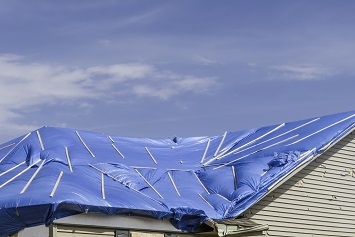The recent hurricane season has apparently prompted OSHA to issue a fact sheet on safely installing plastic tarps on damaged roofs. Reinforced plastic tarps, commonly called blue roofs, provide temporary protection for buildings following severe weather.
Many roofs are sloped, tarps can be slippery when wet, and tarps can conceal tripping hazards such as skylights and vents. OSHA has a fall protection standard employers must follow when employees work on roofs. In the fact sheet, OSHA notes the requirements and also reviews the multiple hazards workers face when tarping roofs.
Electrical Lines
Identifying electrical lines and taking steps to prevent electrocution is a high priority. After a storm, there are often downed overhead power lines. All power lines should be treated as live. The utility company should be contacted to ensure lines are de-energized. Metal ladders should never be used near power lines or in close proximity to energized electrical equipment.
Roof Condition
Before installing a tarp, the capacity of the roof to support workers safely should be determined.
Fall Protection
OSHA requirements at 29 Code of Federal Regulations (CFR) 1926.501(b)(10) and 1926.501(b)(11) establish fall protection requirements for low-slope roofs and steep roofs, respectively.
- A low-slope roof has a slope less than or equal to 4 inches (in.) of vertical rise for every 12 in. of horizontal length. When engaged in roofing work on a low-slope roof that has one or more unprotected sides or edges 6 feet (ft) or more above lower levels, workers must be protected from falling by conventional fall protection—that is, guardrail systems, safety net systems, and personal fall arrest systems. Protection can also be provided by a combination of conventional fall protection systems and warning line systems, or a warning line system, or a safety monitoring system. A safety monitoring system is an alternative fall protection option for low-slope roofing work; this requires the designation of a competent person to monitor the safety of workers and to warn them when their work puts them close to a fall hazard. When engaged in roofing work on low-slope roofs 50 ft or less in width, the use of a safety monitoring system without a warning line system is permitted.
- A steep roof has a slope greater than 4 in. vertical per 12 in. horizontal. When working on a steep roof that has one or more unprotected sides or edge 6 ft or more above lower levels, each worker must be protected by guardrail systems with toeboards, safety net systems, or personal fall arrest systems.
Other Recommendations
- Never install a tarp while it is windy or raining.
- Use proper protective equipment, such as hard hats and eye protection, and/or other control measures, such as chutes and barricaded areas, when removing roof debris. This ensures employees on the ground are not exposed to hazards from falling objects.
- Use a roof rake or brush from ground level for debris. If using a ladder, ensure the use of proper safety techniques to prevent falls.
- Whenever possible, avoid getting on the roof when tasks can be done from ladders or other stable platforms.
- When accessing the roof, lean the ladder at a safe angle—that is, at a 4:1 ratio (1 ft away from the building at the bottom for each 4 ft of ladder length to the roof eave), and make sure the ladder extends 3 ft above the roof edge.
- Watch for tripping hazards, including vent stacks, satellite dishes, lightning arresting components, and cables and cleats holding down the tarp.
- Do not walk on a tarp. A tarped roof will be very slippery, especially when wet.
- Watch your step—skylights and other openings that have been tarped over will not be obvious to someone walking on the roof.
OSHA’s blue roof fact sheet is at https://www.osha.gov/Publications/OSHA3926.pdf. An OSHA guidance document, Fall Protection in Construction, is at https://www.osha.gov/Publications/OSHA3146.pdf.

